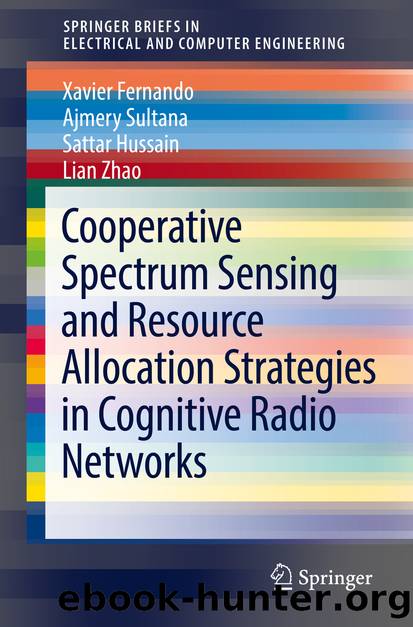Cooperative Spectrum Sensing and Resource Allocation Strategies in Cognitive Radio Networks by Xavier Fernando Ajmery Sultana Sattar Hussain & Lian Zhao

Author:Xavier Fernando, Ajmery Sultana, Sattar Hussain & Lian Zhao
Language: eng
Format: epub
Publisher: Springer International Publishing, Cham
3.4.3 Graph Theory
Graph theory is one of the most extensively used tools for modeling and analyzing the interaction (or contention) in networks. A graph G consists of a set of vertices V and edges E, and is denoted by G = (V, E). These components are mapped to the network elements according to the studied problem. Usually, vertices correspond to entities and edges represent the interaction between these entities. The graph theory could be employed to vast range of networks such as mechanical, transportation, and communication networks, among others. It can offer appropriate tools for solving network-related problems. Generally, graph theory is utilized when the network structure is known a priori [30].
In wireless communications, graph theory is largely used to solve the scheduling and RA problems, especially for problems of high computational effort [31]. In literature, the RA problem was solved using different types of graphs such as vertex-coloring graph, conflict graph, and bipartite graph [32, 33]. For CRNs, the SUs are generally mapped to the vertices and the edges mapping varies according the model definition to characterize certain relation between two vertices. For example, in a conflict or vertex-coloring graph model, an edge between two vertices (SUs’ links) shows that the SUs are in the interference range of each other [25, 31]. Also, the RA for coloring graph problem is comparable to assigning each vertex a color (i.e., assign each link or SU).
If the vertex set V of a graph G can be split into two disjoint subsets V 1, V 2 such that each edge connects two vertices in different subsets, then G is a bipartite graph [34]. A bipartite matching problem is largely used for spectrum assignment and RA in CRNs [35–38]. Generally the two partitions of the bipartite graph are mapped to the SUs and the frequency bands available for assignment. The edges connecting two vertices (SU link and frequency band) for such a problem means that the SU requests (or accepts to be assigned) the corresponding frequency band.
In order to be application specific, coloring and conflict graphs are more appropriate for interference-limited environment. This is similar to the cases of having multiple SUs transmit simultaneously, and thus they can generate high interference to each other. Therefore, using the prescribed conflict or coloring graphs, also called node contention graphs (NCG), assists in modeling this interference in a way that makes simpler the development of a proper RA [31, 39]. On the other hand, the works adopted bipartite graphs usually allowed one SU per band with the owner PU to limit the interference in the system [35, 36]. However, adding preferences to the SUs and PUs guarantees better protection for the primary network as well as improved secondary performance. This is because the PUs’ preferences are typically set according to their tolerated interference. Certainly, graph-based algorithms cannot integrate multiple performance metrics and so, normally, QoS is not guaranteed.
Download
This site does not store any files on its server. We only index and link to content provided by other sites. Please contact the content providers to delete copyright contents if any and email us, we'll remove relevant links or contents immediately.
Linux Device Driver Development Cookbook by Rodolfo Giometti(3957)
Embedded Programming with Modern C++ Cookbook by Igor Viarheichyk(3782)
Implementing Cellular IoT Solutions for Digital Transformation by Dennis McCain(3701)
Embedded Linux Development Using Yocto Project - Third Edition by Otavio Salvador & Daiane Angolini(3549)
TinyML Cookbook by Gian Marco Iodice(3469)
Simplifying 3D Printing with OpenSCAD by Colin Dow(2859)
TinyML Cookbook by Gian Marco Iodice & Ronan Naughton(2623)
Fusion 360 for Makers by Lydia Sloan Cline(2230)
Networking A Beginner's Guide by Bruce Hallberg(2228)
Hands-On Linux for Architects by Denis Salamanca(2073)
But How Do It Know? by J. Clark Scott(2039)
Computers For Seniors For Dummies by Nancy C. Muir(2023)
Raspberry Pi and MQTT Essentials by Dhairya Parikh(1979)
Arduino Project Handbook, Volume 2: 25 Simple Electronics Projects for Beginners by Geddes Mark(1963)
9781803246888-ENHANCING DEEP LEARNING WITH BAYESIAN INFERENCE by Unknown(1918)
Hack and HHVM by Owen Yamauchi(1903)
31 Days Before Your CompTIA A+ Exams (Shanette Luellen's Library) by Benjamin Patrick Conry(1878)
MicroPython Projects by Jacob Beningo(1768)
Hands-On Internet of Things with MQTT by Tim Pulver(1728)
